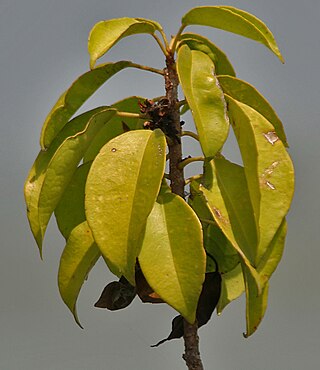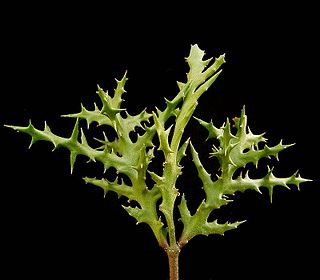Wielandia is a genus of flowering plant, of the family Phyllanthaceae first described as a genus in 1858. The plants are native to Kenya, Madagascar, and to various other islands in the Indian Ocean.

Omphalea is a plant genus of the family Euphorbiaceae first described as a genus in 1759. It is native to tropical parts of the Americas, the West Indies, Asia, Australia, and Africa.
Aparisthmium is a plant genus of the family Euphorbiaceae first described as a genus in 1840. It contains only one known species, Aparisthmium cordatum, native to South America and Costa Rica.
Orfilea is a plant genus of the family Euphorbiaceae first described as a genus in 1858. It is native to Madagascar and other islands in the Indian Ocean.
- Orfilea ankafinensis(Baill.) Radcl.-Sm. & Govaerts - W Madagascar
- Orfilea coriaceaBaill. - Comoros, Madagascar
- Orfilea multispicata(Baill.) G.L.Webster - Madagascar
- Orfilea neraudiana(Baill.) G.L.Webster - Mauritius

Chaetocarpus is a plant genus of the family Peraceae, formerly Euphorbiaceae, first described as a genus in 1854. Chaetocarpus species are trees or shrubs. They are native to the Americas, Africa, and Asia. Some species are endangered.
- Chaetocarpus acutifolius(Britton & P.Wilson) Borhidi – Sierra de Moa in Cuba
- Chaetocarpus africanusPax – C Africa
- Chaetocarpus castanocarpus(Roxb.) Thwaites – SE Asia, Yunnan, Assam, Bangladesh, Sri Lanka
- Chaetocarpus cordifolius(Urb.) Borhidi – Cuba, Hispaniola, Jamaica
- Chaetocarpus coriaceusThwaites – Sri Lanka
- Chaetocarpus cubensisFawc. & Rendle – Cuba
- Chaetocarpus echinocarpus (Baill.) Ducke – Bolivia, Brazil
- Chaetocarpus ferrugineusPhilcox – Sri Lanka
- Chaetocarpus gabonensisBreteler – Gabon
- Chaetocarpus globosus(Sw.) Fawc. & Rendle – Jamaica, Cuba, Dominican Rep.
- Chaetocarpus myrsinitesBaill. – Bolivia, Brazil
- Chaetocarpus parvifoliusBorhidi – Cuba
- Chaetocarpus pearceiRusby – Bolivia
- Chaetocarpus pubescens(Thwaites) Hook.f. – Sri Lanka
- Chaetocarpus rabarabaCapuron – Madagascar
- Chaetocarpus schomburgkianus(Kuntze) Pax & K.Hoffm. – Colombia, Venezuela, 3 Guianas, NW Brazil
Benoistia is a genus of shrubs or trees of the spurge family (Euphorbiaceae) and the monotypic subtribe Benoistiinae. It was first described as a genus in 1939. The entire genus is endemic to Madagascar. It is dioecious.
- Benoistia orientalisRadcl.-Sm. - N + E Madagascar
- Benoistia perrieriH.Perrier & Leandri - Madagascar
- Benoistia sambiranensisH.Perrier & Leandri - N Madagascar
Tannodia is a plant genus of the family Euphorbiaceae first described as a genus in 1861. It is native to Africa, Madagascar, and Comoros. It is dioecious.
- Tannodia congolensis - Zaïre
- Tannodia cordifolia - Comoros, Madagascar
- Tannodia grandiflora - Diana Region in Madagascar
- Tannodia nitida - Atsinanana in Madagascar
- Tannodia obovata - Atsinanana in Madagascar
- Tannodia pennivenia - Atsinanana in Madagascar
- Tannodia perrieri - Madagascar
- Tannodia swynnertonii - Tanzania, Mozambique, Zimbabwe
- Tannodia tenuifolia - Kenya, Tanzania, Malawi, Mozambique, Zimbabwe, Zambia

Excoecaria is a plant genus of the family Euphorbiaceae, formally described by Linnaeus in 1759. The genus is native to the Old World Tropics.
Stachyandra is a plant genus in the family Picrodendraceae first described as a genus in 1990.

Uapaca is a genus of plant, in the family Phyllanthaceae first described as a genus in 1858. It is the only genus comprised in the tribe Uapaceae. The genus is native to Africa and Madagascar. Uapaca is dioecious, with male and female flowers on separate plants.
Decaryochloa is a genus of Madagascan bamboo in the grass family.
Euphorbia analalavensis is a species of plant in the family Euphorbiaceae. It is native to northern and western Madagascar and the Comoro Islands. Its natural habitat is dry deciduous forest and rocky areas between 50 and 400 meters elevation. It is threatened by habitat loss.

Euphorbia stenoclada is a species of plant in the family Euphorbiaceae. It is native to Madagascar and the Mozambique Channel Islands. Its natural habitats are subtropical or tropical dry forests, subtropical or tropical dry shrubland, and rocky areas. It is threatened by habitat loss.
Craspidospermum is a monotypic genus of plant in the family Apocynaceae endemic to Madagascar. As of August 2013 the World Checklist of Selected Plant Families recognises the single species Craspidospermum verticillatum.
Chapelieria is a monotypic genus of flowering plants in the family Rubiaceae. The genus contains only one species, viz. Chapelieria madagascariensis, which is endemic to Madagascar.
Faguetia is a monotypic genus of trees in the subfamily Anacardioideae of the cashew and sumac family Anacardiaceae. It contains the single species Faguetia falcata, which is endemic to eastern Madagascar.
Gereaua is a monotypic genus of flowering plants belonging to the family Sapindaceae. It only contains one species, Gereaua perrieri.
Hartogiopsis is a monotypic genus of flowering plants belonging to the family Celastraceae. It contains only one species, Hartogiopsis trilobocarpa.
Landiopsis is a monotypic genus of flowering plants belonging to the family Rubiaceae. It only contains one known species, Landiopsis capuronii.
Humbertiodendron is a monotypic genus of flowering plants belonging to the family Trigoniaceae. The only species is Humbertiodendron saboureaui.





